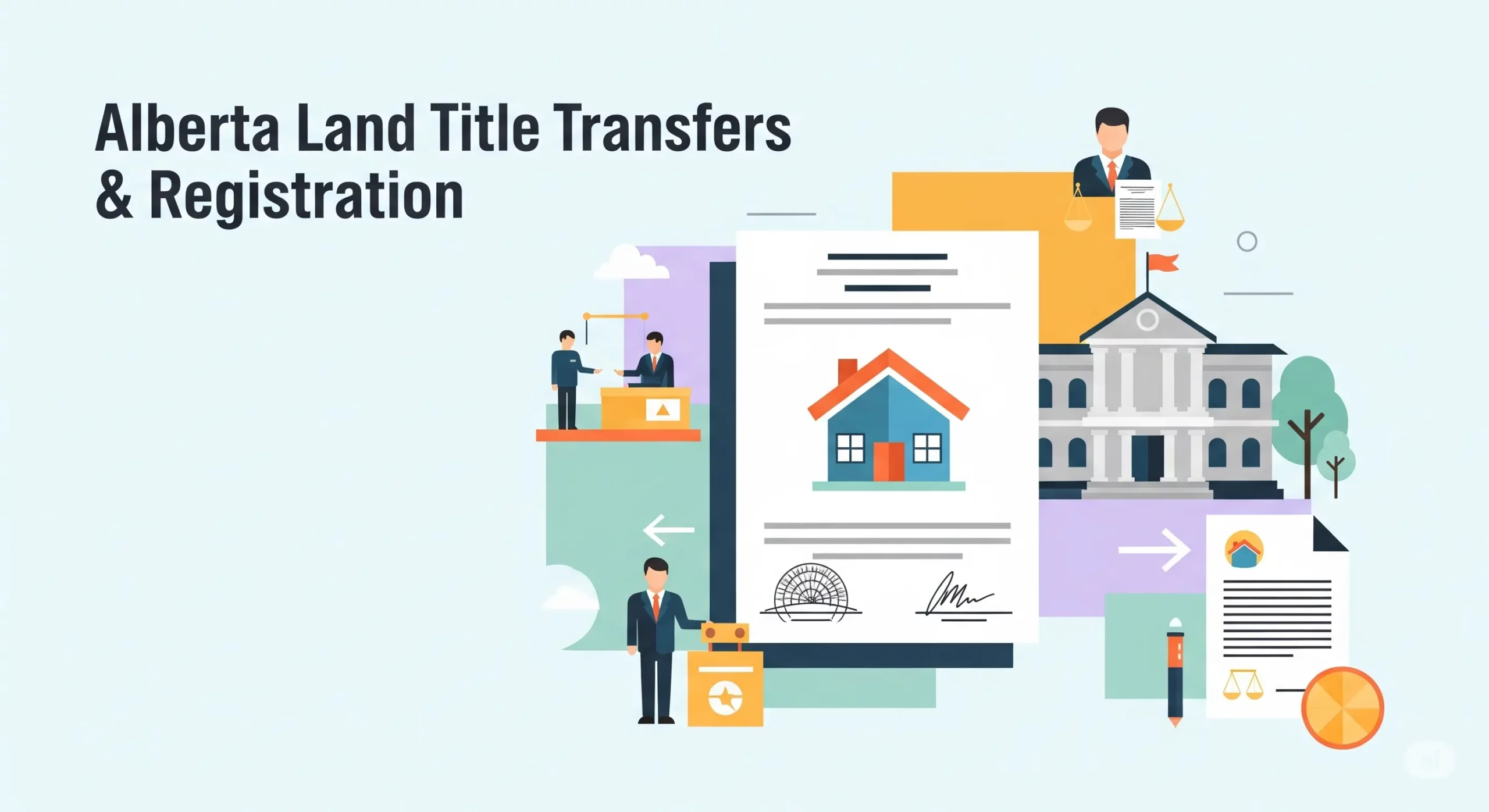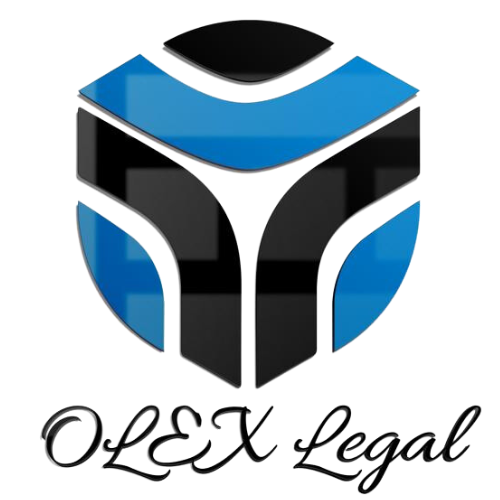
25 Jul The Definitive 2025 Guide to Alberta Land Title Transfers & Registration
Property ownership in Alberta is built on a foundation of security and certainty, a system designed to provide clarity and confidence to every landowner. This framework, however, is not static. As we navigate 2025, the province’s real estate landscape is undergoing significant procedural and financial shifts, from evolving fee structures to extended processing timelines. For prospective and current property owners, understanding these changes is not just beneficial—it is essential for protecting one’s most valuable asset.
This guide serves as a comprehensive resource for navigating the entire lifecycle of land title transfers and registrations in Alberta. It is designed to demystify the process, from the foundational principles of the province’s unique ownership system to the practical steps of transferring a title. We will explore the critical role of the Alberta Land Titles Office, the increasing reliance on digital tools like the Spatial Information System (SPIN2) portal, and the nuanced costs involved, including recent legislative changes that have dramatically altered the financial calculations for certain transactions. Whether you are a first-time homebuyer, an investor structuring a commercial deal, or a family planning an estate transfer, this article provides the detailed knowledge required to proceed with assurance.
What You’ll Find in This Guide
- How to change land title ownership, step by step
- Methods to find land titles, documents, or survey plans
- Procedures for registering a land title document or plan
- A breakdown of land titles assurance fees and other costs
- Guidance on foreign ownership of land and its unique considerations
- Where to find and how to use the land titles procedures manual
With each section, we aim to clarify not just the “how,” but the “why” behind Alberta’s processes—arming you with practical tips and up-to-date insights so you can navigate today’s real estate environment with confidence.
Section 1: The Foundations of Alberta Property Ownership: Beyond the Physical Deed
Understanding how property ownership is recorded and proven in Alberta is the first step toward mastering the transfer process. The province employs a highly reliable framework that differs fundamentally from older, deed-based systems, offering a superior guarantee of ownership in the modern era.
The Torrens System: Your Guarantee of Ownership
Alberta’s real estate transactions are governed by the Land Titles Act, which establishes a registration framework known as the Torrens system. Unlike historical systems where a chain of physical deeds was required to prove ownership, the Torrens system operates on the principle of “title by registration.” The core concept is that the government’s central registry is the ultimate, authoritative source of truth regarding property ownership.
Under this system, the Alberta Land Titles Office issues a Certificate of Title for each parcel of land. This certificate is more than just a record; it is a government-backed guarantee of ownership. It provides conclusive proof that the person named on the title is the legal owner, free from any other claims or encumbrances, except for a few specific statutory exceptions that are typically registered on the title itself, such as utility rights-of-way or municipal easements. This state guarantee eliminates the need for buyers to conduct exhaustive historical investigations to ensure a seller has a valid claim, thereby streamlining transactions and providing unparalleled security to property owners.
Proof of Ownership in a Digital Age
Given the principles of the Torrens system, the question of how to prove ownership is answered not by producing a dusty, physical deed, but by accessing the official government registry. The physical paper copy of a title certificate an owner might hold is merely a snapshot; the real, legally binding title exists as a digital record within the Land TitlGiven the principles of the Torrens system, the question of how to prove ownership is answered not by producing a dusty, physical deed, but by accessing the official government registry. The physical paper copy of a title certificate an owner might hold is merely a snapshot; the real, legally binding title exists as a digital record within the Land Titles Office’s database.
How to Access Proof of Ownership
There are two primary methods for formally proving ownership:
- SPIN2 Title Search:
The most common and immediate method is to perform a title search through the government’s Spatial Information System (SPIN2) online portal. For a fee of approximately $10 to $20, anyone can access a real-time digital copy of a title certificate. This document shows the current registered owners, the legal description of the property, and a list of all registered encumbrances, such as mortgages, caveats, and liens. To order copies of title, or to create your document registration request form, you can use the SPIN2 website. The process is straightforward and can be completed online, making it easy for buyers, sellers, lawyers, and even curious neighbors to access official records for any parcel of land in the province. - Certified Copy of Title:
For more formal purposes, such as court proceedings or satisfying the requirements of a financial institution, a “Certified Copy of Title” is required. This official document is obtained by submitting Form 31: Request for Certified Copy to the Land Titles Office, along with the property’s title number or legal description and a $10 fee. This certified copy serves as definitive, court-admissible evidence of ownership.
By using these digital tools, property owners and interested parties can swiftly obtain up-to-date, authoritative proof of ownership—no detective work or paper trail required.
Modernizing Land Titles and Surveys: What’s Changing?
Behind the scenes, the Land Titles and Surveys system is undergoing significant upgrades designed to meet the demands of an increasingly digital and fast-paced marketplace. Gone are the days of cumbersome manual paperwork and lengthy processing times.
Recent and ongoing improvements include:
- Enhanced Digital Access: Processes that once required in-person visits or snail mail submissions are being migrated online. Modern web portals now allow users to initiate transactions, submit required documents, and track progress from their office or mobile device.
- Faster Turnaround Times: System upgrades and streamlined workflows are cutting down on delays. Task automation, integrated databases, and improved digital infrastructure mean that routine title registrations, searches, and surveys can often be completed in days instead of weeks.
- Improved Data Security: With property records transitioning to cloud-based and encrypted platforms, robust cybersecurity measures are in place to protect sensitive information. Secure logins and advanced authentication keep data in the right hands.
- Greater Transparency and Self-Service: Property owners and professionals benefit from clearer status updates, intuitive dashboards, and real-time notifications throughout the transaction process. This new transparency reduces confusion and eliminates much of the uncertainty inherent in legacy systems.
These advancements ensure that Alberta’s property system stays on pace with jurisdictions like Ontario or British Columbia, furthering its reputation as one of Canada’s most reliable and user-friendly frameworks.
Whether you are a homeowner, real estate professional, or lawyer, these enhancements promise a modern, efficient experience—one that aligns with the expectations of today’s digital world.
A Critical Choice: Structuring Your Ownership
When more than one person is registered on a title, the structure of that co-ownership has profound and often misunderstood legal consequences, particularly concerning inheritance. The choice made on the Transfer of Land form is not a minor administrative detail; it is a binding estate planning decision that dictates what happens to a person’s interest in the property upon their death. The two main forms of co-ownership in Alberta are Joint Tenancy and Tenancy in Common.
- Joint Tenancy: This form of ownership includes what is known as the “right of survivorship.” When one joint tenant dies, their interest in the property automatically and immediately transfers to the surviving joint tenant(s). This transfer occurs outside of the deceased’s will and bypasses the often lengthy and costly probate process. Because of this seamless transition, Joint Tenancy is the most common form of ownership for married couples or long-term partners.
- Tenancy in Common: In this structure, each co-owner holds a distinct, specified share of the property. These shares can be equal (e.g., 50/50) or unequal (e.g., 70/30), and each owner can deal with their share independently. Crucially, there is no right of survivorship. When a tenant in common dies, their share does not automatically go to the other co-owners. Instead, it becomes an asset of their estate and is distributed according to the instructions in their will (or by provincial intestacy laws if there is no will). This means the property interest must go through the probate process.
A critical point of caution is that under the Land Titles Act, Tenancy in Common is the default form of ownership. If the Transfer of Land document does not explicitly state that the new owners are to be “Joint Tenants,” the Land Titles Office will register them as Tenants in Common by default. This can lead to unintended and often undesirable outcomes.
Consider a scenario where aging parents decide to add their adult child to the title of their home for convenience, intending for the child to inherit the property easily. If the transfer form is completed without specifying “as Joint Tenants,” they will be registered as Tenants in Common. If that child were to predecease the parents, their one-third share in the family home would not revert to the parents. Instead, it would pass to the child’s own estate, potentially going to their spouse or even creditors, creating a complex and distressing co-ownership situation for the parents. This demonstrates that the decision of how to structure ownership is inextricably linked to estate planning. The question is not simply a legal definition but a personal one: “Who do you want to inherit your interest in this property, and do you want that to happen automatically or through the formal process of your will?”
Section 2: The Practical Guide to Transferring Property Titles in Alberta
With a foundational understanding of Alberta’s ownership system, we can turn to the practical mechanics of transferring a title. Whether the transfer is part of a sale, a gift between family members, or an estate settlement, the process is formal and requires meticulous attention to detail.
Before diving in, it’s helpful to appreciate how the Land Titles Office operates and the importance of using the correct forms. The Land Titles Office is responsible for maintaining accurate, up-to-date records of property ownership across the province. Their procedures are strict—every “i” dotted and “t” crossed—so understanding their processes and documentation requirements is essential.
The Standard Transfer: Key Steps and Documents
A typical property transfer follows a structured legal process, beginning with a purchase agreement and culminating in the registration of the new owner on the title. While the steps can vary based on the transaction’s complexity, the core documentation remains consistent.
The central document in any transfer is the Transfer of Land (Form 6), which is available from the Alberta Land Titles Office. This form must be completed with absolute precision, as even minor errors can lead to rejection. The critical information required includes:
- The full legal names of the current owners (transferors) and the new owners (transferees).
- The precise legal land description of the property, which is found on the existing title certificate and is distinct from the civic or mailing address.
- The “consideration,” which is the actual amount of money or value exchanged for the property.
- The fair market value of the property, including the land and all buildings, which is used to calculate the registration fees.
In addition to the Transfer of Land form, several supporting documents are required. An Affidavit of Execution must be sworn by a witness to the transferor’s signature, and an Affidavit of Value must be sworn by the transferee to attest to the property’s market value. Furthermore, depending on the circumstances, documents related to the Dower Act may be necessary to confirm that spousal rights to the matrimonial home have been addressed.
Given the complexity of these requirements, it’s important to note that staff at the Land Titles Office cannot provide assistance with completing these forms. The process is designed to be rigorous to protect all parties’ interests, so the office strongly recommends consulting a legal professional to ensure all documentation is accurate and complete.
Taking the time to familiarize yourself with the Land Titles Office’s expectations—and seeking help where needed—can save significant time, expense, and frustration, ensuring your title transfer proceeds smoothly and stands up to any subsequent scrutiny.
The Standard Transfer: Key Steps and Documents
A typical property transfer follows a structured legal process, beginning with a purchase agreement and culminating in the registration of the new owner on the title. While the steps can vary based on the transaction’s complexity, the core documentation remains consistent.
The central document in any transfer is the Transfer of Land (Form 6), which is available from the Alberta Land Titles Office. This form must be completed with absolute pre
Submitting Your Completed Documents
Once you’ve assembled all the necessary documents and double-checked every signature and affidavit, the next question becomes: how do you actually submit your package to Land Titles? While in-person counters may be closed, you still have reliable options to ensure your paperwork reaches its destination safely.
You can send your completed packages via:
- Courier Service: Reputable providers like Purolator, FedEx, and UPS offer tracked delivery for added peace of mind.
- Canada Post: Registered mail or Xpresspost are both suitable choices if you prefer using the postal system.
For those in a hurry or who value convenience, most courier companies can deliver directly to Document Reception counters during business hours, even when public walk-ins are not accepted. Just be sure to include all forms and supporting affidavits to avoid unnecessary delays or rejections.
Common Scenario: How to Add a Spouse or Family Member to a Title
A frequent reason for a title transfer is to add a spouse, child, or other family member as a co-owner. It is crucial to understand that this is not a simple “name change” but a formal transfer of a partial interest in the property. As such, it requires the completion of the same Transfer of Land form used in a sale.
In these cases, the “consideration” can be nominal, such as $1 or “love and affection,” but the fair market value of the property must still be accurately declared on the accompanying affidavit, as this value is used to calculate the government registration fees.
The most significant pitfall in this process involves properties with an existing mortgage. Nearly all mortgage agreements include a “due on sale” clause. This clause gives the lender the right to demand full repayment of the loan if any interest in the property is transferred without their consent. Adding a name to the title constitutes such a transfer. Therefore, it is absolutely essential to obtain the lender’s prior written consent before filing the transfer documents with the Land Titles Office. Failing to do so is a breach of the mortgage contract and could, in a worst-case scenario, trigger foreclosure proceedings. While lenders often consent to adding a spouse, they may require the new co-owner to undergo a credit check and formally agree to be bound by the mortgage terms through an assumption agreement.
After a Loss: Transferring Title from a Deceased Owner
When a property owner passes away, the process for transferring the title depends entirely on the form of ownership that was established when they acquired the property.
- If the Deceased was a Joint Tenant: The process is relatively straightforward and is designed to reflect the right of survivorship. The surviving joint tenant(s) do not need to go through the courts or probate. Instead, they submit a Statutory Declaration regarding Proof of Death to the Land Titles Office. This declaration must be accompanied by an original or notarized copy of an official death certificate (e.g., from Vital Statistics or a funeral director). Upon registration of these documents, the deceased’s name is removed from the title, and the surviving owner(s) become the sole legal owners.
- If the Deceased was a Tenant in Common or a Sole Owner: The process is more complex as the deceased’s interest in the property becomes an asset of their estate. The executor named in the will (or an administrator appointed by the court if there is no will) must first apply to the Surrogate Court of Alberta for a Grant of Probate or Letters of Administration. This court order officially validates the will and grants the executor the legal authority to manage the estate’s assets. The executor then submits this original, court-sealed Grant to the Land Titles Office along with an Application for Transmission. This transfers the title from the deceased’s name into the name of the “Estate of, represented by [Executor’s Name].” Once the title is in the estate’s name, the executor can then proceed to either sell the property or transfer it to the beneficiaries as directed by the will.
Section 3: Decoding the Costs: A 2025 Breakdown of Alberta’s Title Transfer Fees
One of the most pressing concerns for anyone involved in a real estate transaction is the cost. In Alberta, the cost structure is unique and has seen significant updates in late 2024 and early 2025. Understanding these fees is critical for accurate budgeting.
The “Alberta Advantage”: No Provincial Land Transfer Tax
A significant financial benefit for property buyers in Alberta is the absence of a provincial Land Transfer Tax. In other provinces, such as Ontario and British Columbia, buyers face a substantial tax calculated as a percentage of the property’s purchase price, often adding thousands or tens of thousands of dollars to closing costs. Alberta forgoes this tax, replacing it with a much more modest system of registration fees, which keeps the upfront cost of acquiring property comparatively low.
Calculating Your Fees: The Land Title and Mortgage Registration Formula
While there is no land transfer tax, the Alberta government does charge fees for the service of registering a title transfer and any associated mortgage. As of an increase in October 2024, these fees are calculated using a clear, two-part formula:
- A base fee of $50 per registration.
- A variable levy of $5 for every $5,000 (or portion thereof) of the property’s fair market value (for a transfer) or the mortgage’s principal amount (for a mortgage registration).
To illustrate, consider the purchase of a home for a fair market value of $400,000, with a new mortgage of $320,000:
- Land Title Transfer Fee Calculation:
- Base Fee: $50
- Variable Levy: ($400,000 / $5,000) = 80 portions. 80 * $5 = $400.
- Total Transfer Fee: $50 + $400 = $450
- Mortgage Registration Fee Calculation:
- Base Fee: $50
- Variable Levy: ($320,000 / $5,000) = 64 portions. 64 * $5 = $320.
- Total Mortgage Fee: $50 + $320 = $370
In this example, the total government registration fees would be $820 ($450 + $370).
CRITICAL 2025 UPDATE: The New Mortgage Levy Rules and Their Financial Impact
On January 31, 2025, a seemingly minor legislative amendment came into force that has profound financial implications for certain types of borrowing, particularly in the commercial real estate sector. The government repealed a provision in the Land Titles Act that previously allowed the registration levy for a mortgage to be calculated based on the appraised value of the land if that value was lower than the principal amount of the mortgage being registered.
This change means that the mortgage registration levy is now always calculated based on the full principal amount of the mortgage, regardless of the underlying property’s value. While this does not affect most standard residential transactions where the mortgage amount is less than the home’s value, its impact on commercial financing is dramatic.
This legislative shift fundamentally alters the financial strategy for large-scale and multi-jurisdictional lending in Alberta. It was common practice for national lenders to secure a large credit facility (e.g., $50 million) with a blanket mortgage registered against a portfolio of properties across Canada, one of which might be an Alberta property worth only a fraction of the total loan. Previously, the Alberta registration fee could be based on the local property’s lower value. Now, the fee is based on the entire $50 million face value of the mortgage. This change significantly erodes some of Alberta’s “no land transfer tax” advantage for sophisticated commercial borrowers and investors.
The practical effect is a forced recalculation of deal structures. Lenders and borrowers can no longer use a simple, one-size-fits-all mortgage document for national deals without facing potentially massive registration fees in Alberta. This necessitates new, strategic approaches, such as creating smaller, Alberta-specific mortgages, using different security instruments, or re-evaluating the inclusion of Alberta properties in larger financing portfolios altogether. This has created a new and immediate need for expert legal advice on how to structure commercial financing to mitigate these new costs.
To illustrate the magnitude of this change, consider the powerful example of a $20 million mortgage being registered against an Alberta property valued at $2 million:
- Fee Calculation Before January 31, 2025: The levy was based on the $2 million land value. The fee would have been $2,050.
- Fee Calculation After January 31, 2025: The levy is based on the $20 million mortgage principal. The fee is now $20,050.
This is a nearly tenfold increase, demonstrating the critical importance of understanding this new rule.
Summary of Other Costs & Fees
Beyond the primary registration levies, several other costs are involved in a typical transaction. The following table provides a consolidated summary of common government fees, while other expenses are listed below.
| Service/Document | Government Fee (as of Oct 2024 / Jan 2025) |
| Land Title Transfer | $50 base + $5 per $5,000 of value |
| Mortgage Registration | $50 base + $5 per $5,000 of principal |
| Title Search (SPIN2) | ~$10 – $20 |
| Certified Copy of Title | $10 |
| Caveat (General) | $35 |
| Caveat (Securing Money) | $50 + $5 per $5,000 of amount secured |
| Discharge of Lien/Caveat | $10 per title/instrument |
Other potential expenses to budget for include:
- Legal Fees: For a standard transfer, legal fees typically range from $500 to $1,500, covering document preparation, title searches, and submission management. More complex cases involving encumbrances or corporate structures may incur higher fees.
- Title Insurance: This is an optional but highly recommended one-time premium, usually costing between $200 and $500. It protects against a variety of risks, including fraud, survey errors, and issues that may arise during the registration delay period.
- Notary and Courier Fees: These miscellaneous costs for witnessing documents and shipping them to the Land Titles Office can add another $70 to $150 to the total.
Section 4: Navigating Timelines, Delays, and Title Encumbrances
In an ideal world, a property transfer would be registered instantly. However, the operational realities of the Land Titles Office involve significant processing queues. Understanding these timelines, the protections in place, and how to deal with potential roadblocks on a title is crucial for a smooth transaction.
The Reality of 2025 Processing Times
While official procedure manuals may outline a target processing time of 10 to 20 business days for straightforward registrations, the on-the-ground reality in 2025 is vastly different. Due to high volumes and other systemic factors, the Alberta Land Titles Office is experiencing significant backlogs. Current industry reports and legal practitioners indicate that the time from submission of a document to its final registration is approximately 3.5 months, or around 100 days.
For the most up-to-date estimate of processing times, it’s a good idea to check publicly available resources or industry bulletins, as timelines can shift quickly depending on demand and staffing.
This extended delay can be a source of considerable anxiety for both buyers and sellers. Buyers may worry about their ownership status, while sellers may be concerned about lingering liability. It is important to know that the system has a mechanism in place to manage the risks associated with this waiting period.
Your Protection During the Wait: The Pending Registration Queue (PRQ)
To address the challenges posed by long delays, the Land Titles Office uses the Pending Registration Queue (PRQ). When a set of documents, such as a Transfer of Land, is delivered to the Land Titles Office, it is immediately entered into the PRQ and assigned a registration priority number. As the Office notes, “Documents received at our offices will be placed in the queue and processed according to the date received.” This action effectively secures your spot in line.
The PRQ provides critical protection. Even though the formal examination and registration of your transfer may not happen for several months, any other document or claim registered against that title after your submission will rank behind it in priority. For example, if a creditor of the seller attempts to register a lien against the property the day after your transfer was submitted, your purchase will take precedence, and the lien will not attach to the title once it is in your name. This system gives buyers, sellers, and lenders the security of knowing their interests are protected from the moment of submission.
However, this protection is contingent on a perfect submission. If the Land Titles Office examines the documents and finds an error—such as a misspelled name, an incorrect legal description, or a missing signature—the submission will be rejected and marked as “deficient.” The filer is then sent a Notice of Deficiency and is given a 30-day window to correct the error and resubmit. If the deficiency is remedied within this period, the original priority in the queue is maintained. If the 30-day deadline is missed, the submission is cancelled, the priority is lost entirely, and the entire process must be started from scratch.
This system transforms the role of a legal professional from a mere facilitator into an essential risk manager. The long delays create a “risk gap” between the closing date and final registration, and the PRQ is the primary tool for managing it. The value of expert legal counsel in this environment is threefold. First, they ensure perfection in the initial submission, leveraging their expertise to avoid the high-stakes pressure of a 30-day deficiency notice. Second, they provide assurance to anxious clients, clearly explaining how the PRQ protects their interests during the long wait. Finally, for transactions not covered by standard closing protocols (like farm or commercial sales), they can bridge the financial gap by recommending and implementing solutions like Title Insurance. Title insurance can cover the risks of the registration gap, allowing funds to be released and the deal to close on the contractually agreed-upon date, rather than waiting months for final registration.
Clearing the Way: Identifying and Resolving Encumbrances
An encumbrance is any claim or charge registered against a property title that can impede its transfer or diminish its value. The most common types are caveats and liens.
- Caveats: A caveat is a notice registered on title by a party who claims an unregistered interest in the property (e.g., a purchaser under an agreement for sale or a party with a right of first refusal). Its purpose is to “warn” anyone dealing with the property of this claimed interest.
- Liens: A lien is a form of security registered to ensure payment of a debt. A common example is a Construction Lien (formerly Builders’ Lien), filed by a contractor or supplier who has not been paid for work done on the property.
The first step in any transaction is to conduct a title search to identify any such encumbrances. If any are found, they must be resolved before a clear title can be transferred. The resolution process involves filing specific forms with the Land Titles Office:
- To remove a caveat, the person who filed it (the caveator) must provide a signed and notarized Form 25: Withdrawal of Caveat.
- To remove a lien, the lienholder must provide a signed Form 26: Discharge of Lien once the underlying debt has been paid.
If the party who filed the encumbrance refuses to provide the necessary discharge, the landowner may need to apply to the court for an order to have it removed. This is often a complex process of negotiation and legal procedure where the assistance of a lawyer is indispensable.
Section 5: Frequently Asked Questions (FAQ)
Navigating the land title process often raises a number of common questions. This section provides clear, direct answers to some of the most frequently asked questions about property transfers in Alberta.
Q: Does Alberta have a land transfer tax like other provinces?
A: No, Alberta stands out as one of the few provinces without a separate, percentage-based land transfer tax. This significantly reduces closing costs compared to jurisdictions like Ontario or British Columbia. However, all property purchases are subject to Land Title Registration Fees and, if applicable, Mortgage Registration Fees, which are calculated based on the property’s value and the mortgage amount.
Q: Can I claim my land title transfer fees on my income tax return?
A: No. For a principal residence, the Canada Revenue Agency (CRA) does not consider land title fees, legal fees, or other closing costs to be tax-deductible expenses. These costs are considered part of the capital cost of acquiring the property and cannot be used to reduce your taxable income.
Q: Are there any rebates for first-time homebuyers in Alberta for these fees?
A: No, Alberta does not offer any rebates or exemptions on its Land Title or Mortgage Registration fees for first-time homebuyers. The rationale is that the fee system is already substantially more affordable than the land transfer tax regimes in other provinces, which do sometimes offer such rebates to offset their much higher tax burdens.
Q: Can I transfer a property title myself without a lawyer?
A: While it is technically possible for an individual to access and file the necessary forms, it is a complex process that is strongly discouraged for non-professionals. The Alberta Land Titles Office itself states that its staff cannot provide assistance with completing the forms and recommends seeking legal counsel. The risks of self-representation are significant; errors on the forms can lead to rejection, which means losing your priority in the registration queue and facing costly delays of several more months. A lawyer ensures accuracy, manages the process efficiently, and mitigates these substantial risks.
Q: What happens if I add my spouse to the title of my home that has a mortgage?
A: Before you can add anyone to the title of a mortgaged property, you must obtain the prior written consent of your mortgage lender. Adding a name is a formal transfer of ownership interest, which can trigger the “due on sale” clause found in most mortgage contracts. This clause gives the lender the right to demand the entire loan balance be paid immediately. A real estate lawyer can help you navigate the consent process with your lender to ensure the transfer is completed without breaching your mortgage agreement.
Q: With registration taking over 3 months, is my purchase at risk?
A: The system is designed to manage this risk. The Pending Registration Queue (PRQ) protects your transaction by securing its priority on title from the moment your documents are submitted. This prevents subsequent claims filed against the seller from affecting your ownership. For an even higher level of security, especially in commercial, agricultural, or other transactions not covered by standard closing protocols, Title Insurance is a highly recommended tool. It is a one-time insurance policy that protects you against a wide range of potential title defects and fraud, including issues that could arise during the lengthy registration delay.
Section 6: Your Partner in Alberta Real Estate Law: OLEX Legal
Navigating the complexities of Alberta’s evolving land title system requires more than just information; it requires expert guidance, strategic advice, and a commitment to protecting your interests. At OLEX Legal, we provide the clarity and protection necessary to ensure your real estate transactions are handled with the highest degree of professionalism and care.
OLEX Legal is a trusted and leading law firm based in Calgary, Alberta, specializing in real estate law, business law, and wills and estates. Our team is dedicated to helping individuals, families, and businesses navigate their legal challenges with confidence. We have built a reputation for making complex legal processes straightforward and for delivering tailored solutions that meet the unique needs of our clients, from first-time homebuyers to seasoned investors and corporate entities. Our core values of clear communication, commitment to excellence, empathy, and integrity are at the heart of everything we do.
Why Choose OLEX Legal for Your Title Transfer?
In a landscape marked by new fees, procedural delays, and legal nuances, choosing the right legal partner is paramount. OLEX Legal offers a distinct advantage.
- Expert Navigation: Our team possesses an up-to-the-minute understanding of the fee changes and procedural delays impacting Alberta in 2025. We are not just filing paperwork; we are providing strategic advice to protect your interests and your finances, particularly in light of the new mortgage levy rules that affect commercial transactions.
- Risk Mitigation: We ensure your documents are filed correctly the first time, helping you avoid costly rejections and protecting your priority in the Land Titles queue. We expertly manage the complexities of obtaining lender consents for title changes, satisfying Dower Act requirements, and clearing encumbrances from a title so that you can proceed with confidence.
- Integrated Expertise: Our practice extends beyond real estate to include Business Law and Wills & Estates. This integrated knowledge is invaluable. We understand that a title transfer is often an integral part of a larger business strategy or a critical component of a family’s estate plan. We provide holistic advice that considers all angles.
- Client-Centric Service: We believe in clear, transparent advice. Our commitment is to keep you informed and confident at every stage of the process. We will explain every step, answer all your questions, and ensure the entire transaction is as smooth and stress-free as possible.
Whether you are buying your first home, adding a family member to a title, structuring a complex commercial real estate deal, or settling an estate, trust the experts at OLEX Legal to guide you. Contact us today for a consultation and experience a new standard of legal service.
Contact OLEX Legal:
- Address: 160 Quarry Park Boulevard SE, Suite 300, Calgary, Alberta, T2C 3G3
- Phone: 587-333-4358
- Email: contact@olexlegal.ca
- Hours: Monday – Friday, 9:30 AM – 5:00 PM
Disclaimer: The information provided in this article is for general informational purposes only and does not constitute legal advice. The law is subject to change, and the application of legal principles can vary significantly based on specific facts and circumstances. You should not act or refrain from acting based on this information without first seeking professional legal counsel from a qualified professional. Please contact OLEX Legal or another qualified legal professional to obtain advice with respect to any particular issue or problem.



















































